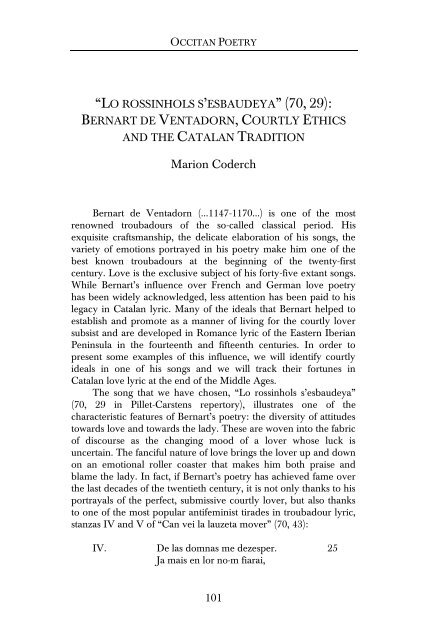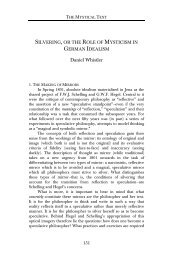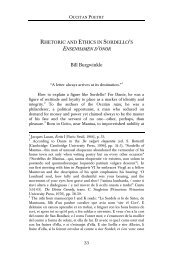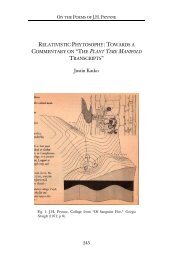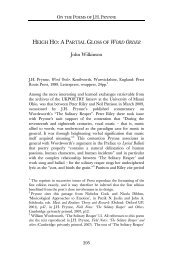Lo rossinhols s'esbaudeya
Lo rossinhols s'esbaudeya
Lo rossinhols s'esbaudeya
You also want an ePaper? Increase the reach of your titles
YUMPU automatically turns print PDFs into web optimized ePapers that Google loves.
OCCITAN POETRY<br />
“LO ROSSINHOLS S’ESBAUDEYA” (70, 29):<br />
BERNART DE VENTADORN, COURTLY ETHICS<br />
AND THE CATALAN TRADITION<br />
Marion Coderch<br />
Bernart de Ventadorn (...1147-1170...) is one of the most<br />
renowned troubadours of the so-called classical period. His<br />
exquisite craftsmanship, the delicate elaboration of his songs, the<br />
variety of emotions portrayed in his poetry make him one of the<br />
best known troubadours at the beginning of the twenty-first<br />
century. <strong>Lo</strong>ve is the exclusive subject of his forty-five extant songs.<br />
While Bernart’s influence over French and German love poetry<br />
has been widely acknowledged, less attention has been paid to his<br />
legacy in Catalan lyric. Many of the ideals that Bernart helped to<br />
establish and promote as a manner of living for the courtly lover<br />
subsist and are developed in Romance lyric of the Eastern Iberian<br />
Peninsula in the fourteenth and fifteenth centuries. In order to<br />
present some examples of this influence, we will identify courtly<br />
ideals in one of his songs and we will track their fortunes in<br />
Catalan love lyric at the end of the Middle Ages.<br />
The song that we have chosen, “<strong>Lo</strong> <strong>rossinhols</strong> s’esbaudeya”<br />
(70, 29 in Pillet-Carstens repertory), illustrates one of the<br />
characteristic features of Bernart’s poetry: the diversity of attitudes<br />
towards love and towards the lady. These are woven into the fabric<br />
of discourse as the changing mood of a lover whose luck is<br />
uncertain. The fanciful nature of love brings the lover up and down<br />
on an emotional roller coaster that makes him both praise and<br />
blame the lady. In fact, if Bernart’s poetry has achieved fame over<br />
the last decades of the twentieth century, it is not only thanks to his<br />
portrayals of the perfect, submissive courtly lover, but also thanks<br />
to one of the most popular antifeminist tirades in troubadour lyric,<br />
stanzas IV and V of “Can vei la lauzeta mover” (70, 43):<br />
IV. De las domnas me dezesper. 25<br />
Ja mais en lor no·m fiarai,<br />
101
GLOSSATOR 4<br />
c’aissi com las solh chaptener,<br />
enaissi las deschaptenrai.<br />
Pois vei c’una pro no m’en te<br />
va leis que’m destrui e·m cofon, 30<br />
totas las dopt’e las mescre,<br />
car be sai c’atretals se son.<br />
V. D’aisso·s fa be femna parer<br />
ma domna, per qu’e·lh o retrai,<br />
car no vol so c’om deu voler 35<br />
et so c’om li deveda fai. […]<br />
(1962, pp. 166-168)<br />
IV. I despair of women. No more will I trust them; and<br />
just as I used to defend them, now I shall denounce<br />
them. Since I see that none aids me against her who<br />
destroys and confounds me, I fear and distrust all of<br />
them, for I know very well that they are all alike.<br />
V. In such things my lady acts like a woman, and for this<br />
I reproach her. She does not want to do what she should,<br />
and she does what is forbidden to her. […]<br />
These verses show a face of the lyric poet that can hardly<br />
surprise the reader familiar with Provençal poetry. Antifeminism<br />
lurks constantly behind praise of the lady in troubadour poetry; it<br />
could not be otherwise, considering the dominant role of misogyny<br />
in medieval culture and education. Criticism is often aimed at<br />
feminine gender as a whole, but we can also find a good number of<br />
cases where the target is a particular lady to whom the love<br />
discourse is addressed. Bernart’s poetry is no exception: as Gérard<br />
Gouiran has shown, criticism of the lady is present in 60% of his<br />
songs (1996, p. 1). Bernart de Ventadorn masters the balance<br />
between praise and criticism; the vehemence of his poetic voice<br />
makes the disapproval of the lady’s actions look like the rants of a<br />
bewildered lover. This strategy allows the poet to combine the<br />
traditional background of love lyric with the civilizing trends of<br />
courtoisie; antifeminist thought, mistrust and hostility coexist with<br />
deference and praise towards women.<br />
The intertwining of positive and negative views of the lady is<br />
one of the typical features of troubadour poetry in “<strong>Lo</strong> <strong>rossinhols</strong><br />
102
CODERCH – LO ROSSINHOLS S’ESBAUDEYA<br />
s’esbaudeya.” The seven full stanzas of the text present us with a<br />
variety of motifs that, while already present in classical troubadour<br />
lyric, enjoy a remarkable success in Catalan lyric of the fourteenth<br />
and fifteenth centuries. Among them are the image of the courtly<br />
lover as a potential target for mockery and deception, the<br />
uselessness of strictly observing the courtly love code, the depiction<br />
of the lady as a whimsical and cruel character, and the<br />
personification of <strong>Lo</strong>ve as an accomplice of the lady’s tricks. In our<br />
reading of the text we will identify these features and track their<br />
resonance in the works of later Catalan and Valencian poets:<br />
I. <strong>Lo</strong> <strong>rossinhols</strong> s’esbaudeya<br />
josta la flor el verjan,<br />
e pren m’en tan grans enveya<br />
qu’eu no posc mudar no chan.<br />
Mas no sai de que ni de cui 5<br />
car eu non am me ni autrui<br />
e fatz esfortz car sai faire<br />
bo vers, pois no sui amaire.<br />
II. Mais a d’Amor qui domneya<br />
ab orgolh et ab enjan 10<br />
que cel que tot jorn merceya<br />
ni·s vai trop umilian.<br />
C’a penas vol Amors celui<br />
qu’es francs e fis si com eu sui.<br />
So m’a tout tot mon afaire 15<br />
c’anc no fui faus ni trichaire.<br />
III. C’aissi com lo rams si pleya<br />
lai o·l vens lo vai menan,<br />
era vas lei que·m guerreya<br />
aclis per far so coman. 20<br />
Per aisso m’afol’e·m destrui,<br />
don a mal linhatge redui,<br />
c’ams los olhs li don a traire<br />
s’autre tort me pot retraire.<br />
IV. Soven me rept’e·m plaideya 25<br />
e’m vai ochaisos troban,<br />
e can ilh en re feuneya,<br />
103
GLOSSATOR 4<br />
vas me versa tot lo dan.<br />
Gen joga de me e·s desdui,<br />
que d’eus lo seu tort me conclui. 30<br />
Mas ben es vertatz que laire<br />
cuida tuih sion sei fraire.<br />
V. Om no la ve que no creya<br />
sos bels olhs e so semblan<br />
e no cre qu’ilh aver deya 35<br />
felo cor ni mal talan,<br />
mas l’aiga que soau s’adui<br />
es peyer que cela que brui.<br />
Enjan fai qui de bon aire<br />
sembla e non o es gaire. 40<br />
VI. De tot loc on ilh esteya<br />
me destolh e·m vau lonhan,<br />
e per so que no la veya<br />
pas li mos olhs claus denan.<br />
Car cel sec Amors que·s n’esdui 45<br />
e cel l’enchaussa qu’ela fui.<br />
Ben ai en cor del estraire<br />
tro que vas midons repaire.<br />
VII. Ja non er, si tot me greya<br />
qu’enquer fin e plaih no·lh man, 50<br />
que greu m’es c’aissi·m recreya<br />
ni perda tan lonc afan.<br />
A sos ops me gart e·m estui,<br />
e si non em amic amdui,<br />
d’autr’amor no m’es vejaire 55<br />
que ja mais mos cors s’esclaire.<br />
VIII. Enaissi fos pres com eu sui<br />
Mos Alvernhatz, e foram dui,<br />
que plus no·s pogues estraire<br />
d’en Bel Vezer de Belcaire. 60<br />
104
CODERCH – LO ROSSINHOLS S’ESBAUDEYA<br />
IX. Tristan, si no·us es veyaire,<br />
mais vos am que no solh faire. 1<br />
I. The nightingale rejoices beside the blossom on the<br />
branch, and I have such great envy of him that I cannot<br />
keep from singing, though I do not know of what or of<br />
whom, for I do no love myself or any other. Yet I force<br />
myself to write good verse even though I am no lover.<br />
II. Whoever courts with arrogance and deceit gets more<br />
from love than one who pleads every day and goes about<br />
most humbly; for <strong>Lo</strong>ve hardly wants one so honest and<br />
true as I am. Thus she [<strong>Lo</strong>ve] has spoiled everything for<br />
me, since I was never a deceiver or cheater.<br />
III. Just as the branch bends wherever the wind takes it,<br />
so I was bent to do the command of her who wars with<br />
me. For thus she ruins and destroys me, and thus stoops<br />
to bad behavior. I offer her both eyes to pluck out if she<br />
can reproach me with any other fault.<br />
IV. Often she blames me and argues with me and finds<br />
complaints against me, and when she does anything<br />
wrong, she turns all the injury toward me. She acts nobly<br />
indeed when she tricks me and amuses herself<br />
condemning me for her own wrongs! 2 But then it is true<br />
that a thief thinks all men are his brothers.<br />
V. No one sees her who would not believe her beautiful<br />
eyes and her appearance, nor think that she should have<br />
an evil heart or wicked desire. But the water which flows<br />
quietly is worse than that which roars. Whoever seems<br />
gracious and is not so at all practices deceit.<br />
1 Text and translation in Stephen G. Nichols’ edition (Bernart de<br />
Ventadorn 1962, pp. 125-128). I have introduced some changes to<br />
Nichols’ translation, namely the gender marks for <strong>Lo</strong>ve’s personification:<br />
in Nichols’ rendering, <strong>Lo</strong>ve is either a male character or a thing (“it”), but,<br />
considering that it appears as a female character in Provençal texts<br />
(including the present one; see v. 46), I have amended Nichols’ translation<br />
in accordance with this.<br />
2 Italics in Nichols’ text.<br />
105
GLOSSATOR 4<br />
VI. From every place where she may be I turn and go<br />
far away, and in order that I may not see her, I pass by<br />
her with my eyes closed. For <strong>Lo</strong>ve follows the one who<br />
flees and shuns the one who pursues her. Indeed I have a<br />
mind to escape from her until she returns to my lady.<br />
VII. In truth I will not do anything about it, even though<br />
it grieves me to seek peace and to offer her no quarrel;<br />
for it is hard for me thus to renounce and lose such long<br />
suffering. I regard her needs and dedicate myself to her,<br />
and, even if we two are not friends, it does not seem to<br />
me that my heart glows more from any other love.<br />
VIII. May my Alvernhat be taken just as I am, and we<br />
would be two, and he would no longer be able to<br />
withdraw from the Bel Vezer of Beauclaire.<br />
IX. Tristan, even if it does not seem so to you, I love<br />
more than I used to.<br />
STANZA 1<br />
The first conventional motif in this text is the parallel<br />
between love and song, or, more precisely, between the act of<br />
loving and the act of singing. In this poem, the topos of singing is<br />
used to show the singer’s task, usually associated with loving, under<br />
a new light: the lover says that he’s feeling the urge to sing because<br />
of the nightingale, a bird often linked with the act of loving and<br />
love songs. But Bernart challenges the expectations of the audience<br />
by stating that he wishes to sing although he is not amaire, that is,<br />
he is not in love. This severing of the conventional association<br />
between love and song reveals a search for novelty and a wish of<br />
surprising the audience: after the initial astonishment, Bernart’s<br />
public would surely be possessed by curiosity to know how this<br />
dissociation has taken place, and why the troubadour is singing, if<br />
it is not for love. This initial deception of the audience’s<br />
expectations reveals itself as a clever rhetorical artifice aimed at<br />
capturing the public’s attention, while the poem develops<br />
according to the pattern of a conventional love song.<br />
106
CODERCH – LO ROSSINHOLS S’ESBAUDEYA<br />
STANZA 2<br />
It is at the beginning of the second stanza that this<br />
conventional development becomes clearly visible. Taking <strong>Lo</strong>ve as<br />
one of the characters in lyric fiction, the lover blames her<br />
behaviour: she rewards unfaithful lovers, forgetting the loyal ones 3 .<br />
This motif is somewhat frequent in classical troubadour lyric, but<br />
will be constantly present in Catalan poetry of later centuries. One<br />
of the poets who used this topic to display the decadence of courtly<br />
ideals is Pere Torroella (c. 1420-1475). In the satiric poem “Doleuvos,<br />
enemorats”, he describes a brothel visited by men from all<br />
professions and social conditions; no courtly lover, though, is to be<br />
found there. The poet witnesses how men who do not practice<br />
courtly love satisfy all their needs easily and quickly. This makes<br />
him think about lovers who behave in a gentle way (“fan lo<br />
gentill”, v. 91) and long for the good things that he saw mistreated<br />
(“desigant / los béns que viu maltrectar”, vv. 75-76). While courtly<br />
lovers forget what they really must do (“oblidant lo qu·és degut”, v.<br />
94) and obtain nothing but jealousy and anger (vv. 91-96), other<br />
men gather all the benefits in exchange for presents and material<br />
goods, because<br />
dones, ab avinentesa,<br />
basten més donas cobrar<br />
que virtuts, amor ne abtesa<br />
(vv. 78-80; 2004, pp 99-103)<br />
Women would receive presents more gladly than virtues,<br />
love or talent.<br />
These verses dwell on the old antifeminist topic of women’s<br />
materialism, but also portray courtly virtues as naïve and<br />
ridiculous, in contrast with men who combine a pragmatic<br />
mentality with sexual vigour and economic power.<br />
Although the first verses of the stanza are about lovers in<br />
general, from verse 14 onwards the song focuses on the particular<br />
case of the lover. He illustrates the principle exposed in the<br />
previous verses: after having served his lady nobly and faithfully,<br />
he has not been rewarded by <strong>Lo</strong>ve.<br />
3 Since amor is a feminine word in Provençal language, <strong>Lo</strong>ve appears as a<br />
female character in troubadour lyric.<br />
107
GLOSSATOR 4<br />
Complaints about <strong>Lo</strong>ve’s behaviour are far from unusual in<br />
Provençal love lyric. In “Mout a amors sobrepoder” (167, 38),<br />
Gaucelm Faidit (...1172-1203...) depicts a lover who regrets his own<br />
impotence to rebel against <strong>Lo</strong>ve:<br />
Mout a Amors sobrepoder,<br />
qan lieis, que poign’en mi aucir,<br />
mi fai desirar e voler,<br />
e vol q’ieu l’am e qu’il m’azir;<br />
per q’amdui fazem ses faillir<br />
tot son coman d’aqest afaire,<br />
(vv. 1-6; 1965, p. 362)<br />
<strong>Lo</strong>ve has an excessive power, for she makes me desire<br />
and want her [the lady], who strives to kill me, and wants<br />
me to love her and her to hate me; for this reason, we<br />
obey her will without failure in this matter.<br />
The personification of <strong>Lo</strong>ve as a character of the lyric fiction<br />
is a common feature in the works of Catalan and Valencian poets<br />
inspired by the troubadour tradition. Gilabert de Próixita (...1392-<br />
1405...) shows a lover who makes <strong>Lo</strong>ve responsible for the fate of<br />
his sentimental affair in “Amor aysi m’ha fayt sentir”:<br />
Amor aysi m’ha fayt sentir<br />
ab faç plasen son franch perer,<br />
qu’eras m’a tant sobrat poder<br />
que ges no·m say d’amar partir<br />
108<br />
(vv. 1-4)<br />
<strong>Lo</strong>ve has made me feel her true will with a pleasant face,<br />
and now she has overpowered me so that I cannot<br />
depart from loving.<br />
Amor, si·m volguessets aucir<br />
e que no·m fessets tant doler,<br />
ffer m’iets sobiran plaser,<br />
car morria tot mon cossir;<br />
(vv. 8-11)
CODERCH – LO ROSSINHOLS S’ESBAUDEYA<br />
<strong>Lo</strong>ve, if you wanted to kill me without making me<br />
endure so much pain, you would please me enormously,<br />
as all my sufferings would die too.<br />
Be·m fayts, Amor, languen finir,<br />
si muyr axi per ben amar<br />
ab lieys, qui es dona ses par.<br />
(vv. 19-21; 1954, pp. 49-52)<br />
<strong>Lo</strong>ve, you make me die out in languishing if I die for<br />
loving her, who is a lady beyond compare.<br />
In “Apoderat d’emor, per son poder,” Joan Berenguer de<br />
Masdovelles (...1442-1476...) portrays a lover who goes a bit<br />
further: he admits that his feelings for the lady are exclusively due<br />
to <strong>Lo</strong>ve’s power, as he does not consider any lady as worthy of<br />
love:<br />
Apoderat d’emor, per son poder,<br />
en vos amar forsat, enpes ma son,<br />
per so com crech que vuy dona del mon<br />
tant no marex ni deu per dret aver<br />
(vv. 1-4; Aramon i Serra 1938, pp. 217-218)<br />
Under <strong>Lo</strong>ve’s command, and by her power, I have been<br />
forced and compelled to love you, as I think that no lady<br />
in the world deserves love, nor must fairly have it.<br />
In “Gerregar vull ab amor he m’aymia”, also by Joan<br />
Berenguer de Masdovelles, the lover considers <strong>Lo</strong>ve and the lady<br />
as two foes successfully allied against him:<br />
Gerregar vull ab amor he m’aymia,<br />
si be no pusch seguons conech, guonyar<br />
si no la mort, per tal guerra menar,<br />
car llur poder es gran, he senyoria.<br />
(vv. 1-4; Aramon i Serra 1938, pp. 175-176)<br />
I want to make war against <strong>Lo</strong>ve and against my lady<br />
friend, although, as far as I know, I could win nothing<br />
109
GLOSSATOR 4<br />
but death in such a war, for their power and dominion<br />
are strong.<br />
As this example shows, in some cases <strong>Lo</strong>ve’s unfair behaviour<br />
is aligned with the lady’s reprehensible attitude. <strong>Lo</strong>ve plays the role<br />
of a bad lord, an unfaithful master who does not abide by his part<br />
of the feudal agreement. One of the complaints of courtly lovers<br />
against the lady is that the deal between master and servant has<br />
been broken by her actions. The claims that the lover formulates<br />
against <strong>Lo</strong>ve echo the invectives against the lady; moreover, the<br />
similarities between the lady and <strong>Lo</strong>ve are reinforced by the fact<br />
that <strong>Lo</strong>ve is a female character in lyric fiction.<br />
STANZAS 3 & 4<br />
The examples that we have just discussed serve as an<br />
introduction to the contents of the third stanza. Here, the lover<br />
leaves <strong>Lo</strong>ve and turns to the lady. Her character presents some<br />
similarities with the personification of <strong>Lo</strong>ve described by the lady’s<br />
suitor in the previous verses: in spite of the lover’s obedience and<br />
submission, the lady confronts and destroys him. He brands her<br />
attitude as indicating mal linhatge. By placing the lady and <strong>Lo</strong>ve<br />
together in the enemy’s ranks, the lover allows himself the<br />
possibility to blame them. The criticism of the lady’s actions<br />
continues in the fourth stanza: the lover describes her as a playful<br />
and capricious character that fools him only to blame him for her<br />
own mistakes.<br />
STANZA 5<br />
The fifth stanza introduces a new element in the text: the<br />
lady’s physical beauty. The praise of the lady’s ravishing allure is a<br />
conventional element in courtly love lyric. However, the present<br />
situation is slightly different: the lover has not praised the lady so<br />
far; protests against the lady’s attitude rather than singing her<br />
virtues occupied him. This context gives a different sense to the<br />
depiction of the lady’s beauty. In this song, her pleasant<br />
appearance works as a counterpoint to her inner cruelty. Through<br />
the opposition between the lady’s external and internal qualities,<br />
the lover stresses the unfairness of her nature: nobody who sees her<br />
can believe that a vile heart exists under such a lovely appearance.<br />
The final verses of the stanza convey a covered accusation by<br />
110
CODERCH – LO ROSSINHOLS S’ESBAUDEYA<br />
means of a generalization: a person who seems good-natured and<br />
does not act as such is a cheater.<br />
The contrast between the lady’s external beauty and her inner<br />
cruelty is used in courtly lyric to enhance the negative features of<br />
her character. This motif enjoyed popularity in troubadourinspired<br />
Catalan love lyric. In “Es vostre cor d’acer, ab tan fort<br />
tempre”, the Valencian poet Joan Roís de Corella (...1443-1497...)<br />
gives voice to a lover who dedicates a whole song to describe the<br />
torments that love is inflicting upon him, and concludes that all his<br />
trouble comes from the lady’s beauty:<br />
És tot mon dan perquè en vostra imatge<br />
mostrar no es pot la crueldat coberta;<br />
ans vostre gest, que par sia benigne,<br />
quan vull pintar, tinc davant per exemple<br />
(vv. 17-20; 1983, p. 54)<br />
All my pains come from the fact that your image cannot<br />
show the hidden cruelty; on the contrary, when I want to<br />
depict you, what I have in front of me is the benign look<br />
of your countenance.<br />
There are a number of Catalan songs where the only positive<br />
trait in the lady’s portrayal is physical beauty, among a powerful<br />
set of negative moral features 4 . The motif of the lady’s deceptive<br />
appearance as opposed to her inner faults reflects the old<br />
antifeminist cliché that associates women with the material world<br />
and, subsequently, with lies and falsehood. The appearance of the<br />
lady tempts the lover, making him believe in her goodness, and,<br />
finally, dragging him into the ruin of sexual love 5 .<br />
STANZA 6<br />
Here the lover expresses his intention of avoiding and<br />
shunning the lady in the future. All at once, he declares that <strong>Lo</strong>ve<br />
runs away from those who seek her and follows those who avoid<br />
her. Thus, the parallel between the lady and <strong>Lo</strong>ve becomes clear:<br />
4 See, for instance, Joan Berenguer de Masdovelles’ “Amor tots jorns me<br />
presenta” and “En vida muyr, he morint puix guarir” (Aramon i Serra<br />
1938, pp. 92-94).<br />
5 Bloch 1991, pp. 25-31.<br />
111
GLOSSATOR 4<br />
the lover plans to use with his lady the same strategy that he would<br />
use with <strong>Lo</strong>ve, as they behave similarly. The listener might have<br />
the impression that both characters have become interchangeable<br />
within poetic fiction. Verses about the lady and about <strong>Lo</strong>ve are<br />
interspersed because the actions of both characters are assimilated.<br />
STANZA 7<br />
The lover ends up surrendering to <strong>Lo</strong>ve and declaring that he<br />
will continue serving his lady. The justification for his decision<br />
deserves some attention, though: he believes that giving up this<br />
affair would mean wasting all the effort he has put into it. The<br />
struggle for love is seen as an investment that should not be thrown<br />
away. After the criticism of the lady’s actions by the lover, it is<br />
likely that the audience would interpret these words as a display of<br />
cynicism. <strong>Lo</strong>ve service is a long term enterprise that must earn the<br />
lover some compensation for the pain he has endured. The stanza<br />
closes with declarations of love for the lady, and the lover<br />
expresses his desire of submitting himself to her. These verses<br />
culminate the shift in discourse’s direction beginning with the first<br />
stanza: at the start of the song, the poetic voice declared that he<br />
was not in love; as we read on, the characters of <strong>Lo</strong>ve and the lady<br />
appear, and the lover finds an opportunity to blame both for their<br />
behaviour. The fact that blame is shared between <strong>Lo</strong>ve and the<br />
lady shields her from receiving all the criticism for her actions.<br />
Although the song ends with the conventional expressions of<br />
fidelity and submission, the composition as a whole displays<br />
original and witty strategies for presenting the usual topics in a new<br />
light, surprising the audience, and breaking the oneness of poetic<br />
discourse by intertwining positive and negative aspects of the lady.<br />
In the previous pages we had an opportunity to demonstrate that<br />
lyric motifs used by Bernart de Ventadorn in mid-twelfth century<br />
were inherited by Catalan and Valencian poets, and still resonant<br />
three centuries later. Although Pere Torroella, Joan Berenguer de<br />
Masdovelles, Joan Roís de Corella and other poets rendered a<br />
faithful reworking of the classical themes, their choice of the<br />
materials to be revisited was far from unselective. The<br />
disparagement of courtly conventions and the negative depiction of<br />
the lady’s features are in keeping with the historical context of the<br />
late-medieval crown of Aragon. The pessimistic view on the<br />
classical courtly topics mirrors the anxiety of Aragonese nobility<br />
112
CODERCH – LO ROSSINHOLS S’ESBAUDEYA<br />
facing the emergence of trade and bourgeois families. The prospect<br />
of losing the privileges traditionally reserved to the knightly elite<br />
throws a gloomy patina on the old courtly code, revealing its<br />
inefficiency to obtain prestige in a world increasingly driven by<br />
monetary interests (as Torroella’s poem shows). Thus, the<br />
commentary on the transmission of the classical troubadour<br />
heritage to Catalan and Valencian poets of the late Middle Ages<br />
allows us to grasp the spirit of a crucial period in Western history,<br />
when the forces anticipating modern European societies called into<br />
question the old aristocratic values.<br />
REFERENCES<br />
Aramon i Serra, Ramon, ed. Cançoner dels Masdovelles (Manuscrit n.<br />
11 de la Biblioteca de Catalunya). Cançoners Catalans de la<br />
Biblioteca de Catalunya 1. Barcelona: Institut d’Estudis<br />
Catalans / Biblioteca de Catalunya, 1938.<br />
Bernart de Ventadorn. The Songs of Bernart de Ventadorn (Complete<br />
Text, Translations, Notes, and Glossary). Edited by Stephen G.<br />
Nichols, Jr. Chapel Hill: The University of North Carolina<br />
Press, 1962.<br />
Bloch, R. Howard. Medieval Misogyny and the Invention of Western<br />
Romantic <strong>Lo</strong>ve. Chicago: University of Chicago Press, 1991.<br />
Coderch, Marion. Ausiàs March, les dones i l’amor. València:<br />
Institució Alfons el Magnànim, 2009.<br />
Gaucelm Faidit. Les poèmes de Gaucelm Faidit, troubadour du XIIe<br />
siècle. Edited by Jean Mouzat. Paris: Nizet, 1965.<br />
Gilabert de Próixita. Poesies. Edited by Martí de Riquer. Els Nostres<br />
Clàssics A 76. Barcelona: Barcino, 1954.<br />
Gouiran, Gérard. “Du bon usage de l’hérésie en fin’amor chez<br />
Bernart de Ventadorn.” Revue des Langues Romanes 100 (1996):<br />
1-16.<br />
Pillet, Alfred, and Henry Carstens. Bibliographie der Troubadours.<br />
Halle: Max Niemeyer, 1933.<br />
Roís de Corella, Joan. Obra profana. Edited by Jordi Carbonell. La<br />
Unitat 74. València: Eliseu Climent, 1983.<br />
Torroella, Pere. Obra completa. Edited by Robert Archer. Soveria<br />
Mannelli: Rubbettino, 2004.<br />
113
GLOSSATOR 4<br />
Marion Coderch is Professor of Romance Literature at the<br />
University of Barcelona and author of Ausias March, les dones i l'amor<br />
(Institució Alfons el Magnànim, 2009). She is a member of the<br />
IVITRA (Institut Virtual Internacional de Traducció) and BITECA<br />
(Bibliografia de Textos Catalans Antics). Her research focuses on<br />
representations of women and gender in troubadour love lyric.<br />
114


